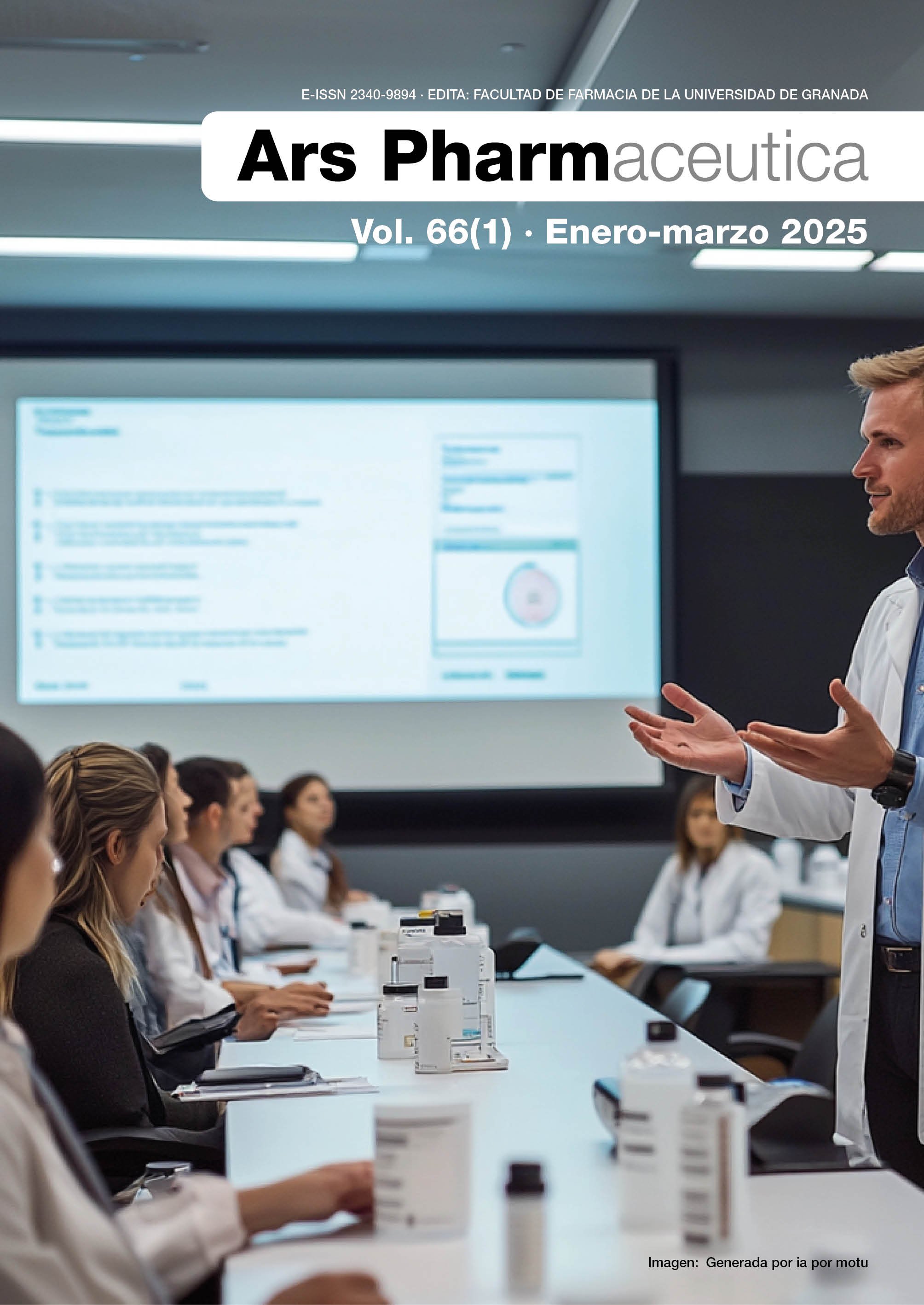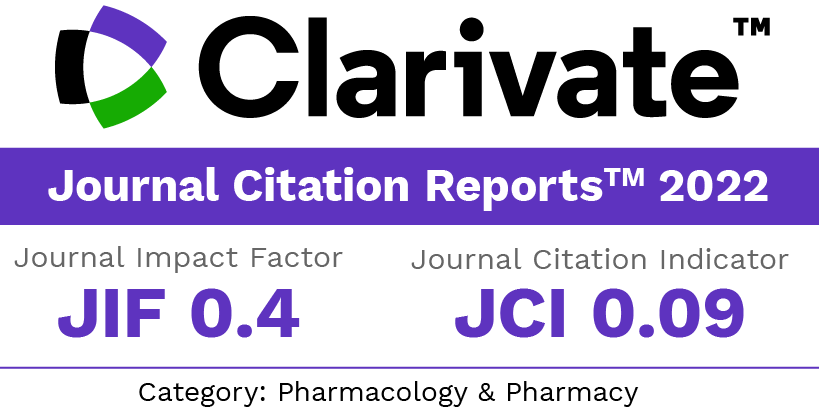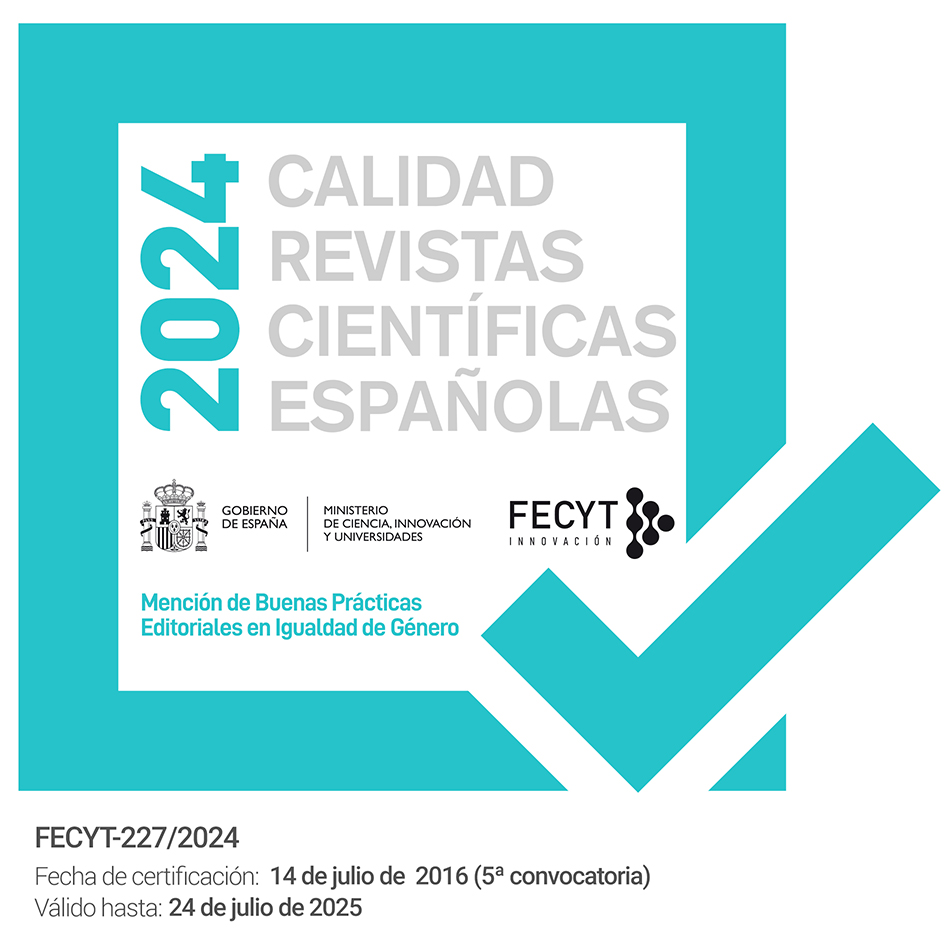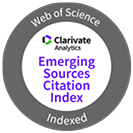Diseño y desarrollo de nanosuspensión de fumarato de quetiapina mediante el método de fresado de medios
DOI:
https://doi.org/10.30827/ars.v66i1.29818Palabras clave:
Fumarato de quetiapine, Nano suspensión, Molienda de medios, Potencial Zeta, Tamaño de partículaResumen
Introducción: Las propiedades críticas y complejas de las moléculas de ingredientes farmacéuticos activos de fumarato de quetiapina Clase II del Sistema de Clasificación Biofarmacéutica que complican la administración oral eficaz de estos ingredientes farmacéuticos activos incluyen una baja solubilidad acuosa y una biodisponibilidad reducida.
Objetivo: El objetivo de esta investigación es desarrollar una formulación de nanosuspensión de fumarato de quetiapina utilizando técnicas de molienda de medios para reducir eficazmente el tamaño de las partículas y mejorar la velocidad de disolución.
Método: Se prepararon nanosuspensiones de fumarato de quetiapina mediante el método de molienda en medios. El proceso de molienda se optimizó mediante el estudio de los efectos de los parámetros críticos del proceso sobre el tamaño de la nanosuspensión mediante un enfoque de diseño factorial. La nanosuspensión preparada se somete a diversas técnicas de caracterización, como tamaño de partícula, potencial Zeta, calorimetría diferencial de barrido, difracción de rayos X en polvo, microscopía electrónica de barrido y evaluación de la tasa de disolución in vitro.
Resultados: Los resultados obtenidos demuestran que el tamaño promedio de partícula de las nanosuspensiones preparadas es de 225 nm con un índice de polidispersidad de 0,530, mientras que el potencial Zeta promedio es de -38,2 mv. La estructura cristalina de la nanosuspensión de fumarato de quetiapina es evidente a partir de calorimetría diferencial de barrido y rayos X en polvo
Conclusión: La velocidad de disolución de la nanosuspensión es significativamente más rápida que la del fármaco fumarato de quetiapina puro, y la liberación acumulada del fármaco de la nanosuspensión es mayor que la del fármaco puro, lo que indica que el uso de la nanotecnología puede mejorar considerablemente la velocidad de disolución.
Descargas
Citas
Sharma OP, Patel V, Mehta T. Design of experiment approach in development of febuxostat nanocrystal: Application of Soluplus® as stabilizer. Powder Technol 2016;302:396–405. Doi:10.1016/j.powtec.2016.09.004 DOI: https://doi.org/10.1016/j.powtec.2016.09.004
Hatahet T, Morille M, Hommoss A, Dorandeu C, Müller RH, Bégu S. Dermal quercetin smartcrystals®: Formulation development, antioxidant activity and cellular safety. Eur J Pharm Biopharm 2016;102:51–63. Doi:10.1016/j.ejpb.2016.03.004 DOI: https://doi.org/10.1016/j.ejpb.2016.03.004
Yao J, Cui B, Zhao X, Wang Y, Zeng Z, Sun C, et al. Preparation, characterization, and evaluation of azoxystrobin nanosuspension produced by wet media milling. Appl Nanosci 2018;8(3):297–307. Doi:10.1007/s13204-018-0745-5 DOI: https://doi.org/10.1007/s13204-018-0745-5
Hu J, Johnston KP, Williams RO. Nanoparticle Engineering Processes for Enhancing the Dissolution Rates of Poorly Water Soluble Drugs. Drug Dev Ind Pharm. 2004;30(3):233–45. Doi:10.1081/DDC-120030422 DOI: https://doi.org/10.1081/DDC-120030422
Stahr PL, Keck CM. Preservation of rutin nanosuspensions without the use of preservatives. Beilstein J Nanotechnol. 2019;10:1902–13. Doi:10.3762/bjnano.10.185 DOI: https://doi.org/10.3762/bjnano.10.185
Jadhav SP, Singh SK, Chawra HS. Review on Nanosuspension as a Novel Method for Solubility and Bioavailability Enhancement of Poorly Soluble Drugs. Adv Pharmacol Pharm. 2023;11(2):117–30. Doi: 10.13189/app.2023.110204 DOI: https://doi.org/10.13189/app.2023.110204
Karakucuk A, Teksin ZS, Eroglu H, Celebi N. Evaluation of improved oral bioavailability of ritonavir nanosuspension. Eur J Pharm Sci. 2019;131(July 2018):153–8. Doi:10.1016/j.ejps.2019.02.028 DOI: https://doi.org/10.1016/j.ejps.2019.02.028
Keck CM, Müller RH. Drug nanocrystals of poorly soluble drugs produced by high pressure homogenisation. Eur J Pharm Biopharm. 2006;62(1):3–16. Doi:10.1016/j.ejpb.2005.05.009 DOI: https://doi.org/10.1016/j.ejpb.2005.05.009
Patel PJ, Gajera BY, Dave RH. A quality-by-design study to develop Nifedipine nanosuspension: examining the relative impact of formulation variables, wet media milling process parameters and excipient variability on drug product quality attributes. Drug Dev Ind Pharm. 2018;44(12):1942–52. Doi:10.1080/03639045.2018.1503296 DOI: https://doi.org/10.1080/03639045.2018.1503296
Flach F, Breitung-Faes S, Kwade A. Model based process optimization of nanosuspension preparation via wet stirred media milling. Powder Technol. 2018;331:146–54. Doi:10.1016/j.powtec.2018.03.011 DOI: https://doi.org/10.1016/j.powtec.2018.03.011
Özcan Bülbül E, Mesut B, Cevher E, Öztaş E, Özsoy Y. Product transfer from lab-scale to pilot-scale of quetiapine fumarate orodispersible films using quality by design approach. J Drug Deliv Sci Technol. 2019;54:101358. Doi:10.1016/j.jddst.2019.101358 DOI: https://doi.org/10.1016/j.jddst.2019.101358
Yadollahi R, Vasilev K, Simovic S. Nanosuspension Technologies for Delivery of Poorly Soluble Drugs. Chen H, editor. J Nanomater. 2015;2015:216375. Doi:10.1155/2015/216375 DOI: https://doi.org/10.1155/2015/216375
Lakshmi P, Kumar GA. Nanosuspension technology: A review. Int J Pharm Pharm Sci. 2010;2(SUPPL. 4):35–40.
Jacob S, Nair AB, Shah J. Emerging role of nanosuspensions in drug delivery systems. Biomater Res. 2020;24(1):1–16. Doi:10.1186/s40824-020-0184-8
Chandra A, Soni RK, Sharma U, Jain SK. Review Article Nanosuspension : an Overview. 2013;3(6):162–7. Doi:10.22270/jddt.v3i6.677 DOI: https://doi.org/10.22270/jddt.v3i6.677
Lemke A, Kiderlen AF, Petri B, Kayser O. Delivery of amphotericin B nanosuspensions to the brain and determination of activity against Balamuthia mandrillaris amebas. Nanomedicine Nanotechnology, Biol Med. 2010;6(4):597–603. Doi:10.1016/j.nano.2009.12.004 DOI: https://doi.org/10.1016/j.nano.2009.12.004
Jacob S, Nair AB, Shah J. Emerging role of nanosuspensions in drug delivery systems. Biomaterials research. 2020;24(1):3. DOI: https://doi.org/10.1186/s40824-020-0184-8
Hallinen T, Soini EJ, Granström O, Ovaskainen Y, Leinonen E, Koponen HJ, Hänninen K. Differential use of extended and immediate release quetiapine: a retrospective registry study of Finnish inpatients with schizophrenia spectrum and bipolar disorders. BMJ open. 2012;2(4):e000915. DOI: https://doi.org/10.1136/bmjopen-2012-000915
Aher SJ, Patil AS, Patil PP, Kale SA, Joshi SC. Preparation and characterization of eudragit based nanosuspensions for the oral drug delivery. 2023;12(5):6301–10. Doi: 10.48047/ecb/2023.12.si5a.0556
Kolipaka T, Sen S, Mane SS, Bajad GD, Dengale SJ, Ranjan OP. Development of posaconazole nanosuspension for bioavailability enhancement: Formulation optimization, in vitro characterization, and pharmacokinetic study. J Drug Deliv SciTechnol.2023;83:104434. Doi:10.1016/j.jddst.2023.104434 DOI: https://doi.org/10.1016/j.jddst.2023.104434
Huang Y, Luo X, You X, Xia Y, Song X, Yu L. The preparation and evaluation of water-soluble SKLB610 nanosuspensions with improved bioavailability. AAPS pharmscitech. 2013;14(3):1236–43. DOI: https://doi.org/10.1208/s12249-013-0005-7
Shirsath N, Marathe D, Jaiswal P, Zawar L. A 32 Factorial Design Approach for Formulation and Optimization of Azilsartan Medoxomil Nanosuspension for Solubility Enhancement. Indian J Pharm Educ Res. 2022;56(2):S365–73. Doi: 10.5530/ijper.56.2s.107 DOI: https://doi.org/10.5530/ijper.56.2s.107
Vadlamudi HC, Yalavarthi PR, Nagaswaram T, Rasheed A, Peesa JP. In-vitro and pharmacodynamic characterization of solidified self microemulsified system of quetiapine fumarate. J Pharm Investig. 2019;49(1):161–72. Doi:10.1007/s40005-018-0397-1
Narala A, Veerabrahma K. Preparation, Characterization and Evaluation of Quetiapine Fumarate Solid Lipid Nanoparticles to Improve the Oral Bioavailability. J Pharm. 2013;2013:1–7. Doi:10.1155/2013/265741 DOI: https://doi.org/10.1155/2013/265741
Medarević D, Djuriš J, Ibrić S, Mitrić M, Kachrimanis K. Optimization of formulation and process parameters for the production of carvedilol nanosuspension by wet media milling. Int J Pharm. 2018;540(1–2):150–61. Doi:10.1016/j.ijpharm.2018.02.011 DOI: https://doi.org/10.1016/j.ijpharm.2018.02.011
Gulsun T, Borna SE, Vural I, Sahin S. Preparation and characterization of furosemide nanosuspensions. J Drug Deliv Sci Technol. 2018;45:93–100. Doi:10.1016/j.jddst.2018.03.005 DOI: https://doi.org/10.1016/j.jddst.2018.03.005
Peter S, Mathews MM, Saju F, Paul S. Development, Optimization and In Vitro Characterization of Eudragit-Ganciclovir Nanosuspension or Treating Herpes Simplex Keratitis. J Pharm Innov. 2023; Doi:10.1007/s12247-023-09723-8 DOI: https://doi.org/10.1007/s12247-023-09723-8
He W, Zhang J, Ju J, Wu Y, Zhang Y, Zhan L, et al. Preparation, characterization, and evaluation of the antitumor effect of kaempferol nanosuspensions. Drug Deliv Transl Res. 2023; Doi:10.1007/s13346-023-01357-0 DOI: https://doi.org/10.21203/rs.3.rs-2229878/v1
Honmane SM, Chimane SM, Bandgar SA, Patil SS. Development and optimization of capecitabine loaded nanoliposomal system for cancer delivery. Indian J Pharm Educ Res. 2020;54(2):376–84. DOI: https://doi.org/10.5530/ijper.54.2.43
Habib BA, Sayed S, Elsayed GM. Enhanced transdermal delivery of ondansetron using nanovesicular systems: Fabrication, characterization, optimization and ex-vivo permeation study-Box-Cox transformation practical example. Eur J Pharm Sci .2018;115:352–61. Doi:10.1016/j.ejps.2018.01.044 DOI: https://doi.org/10.1016/j.ejps.2018.01.044
Zaki RM, Aldawsari MF, Alossaimi MA, Alzaid SF, Devanathadesikan Seshadri V, Almurshedi AS, Aldosari BN, Yusif RM, Sayed OM. Brain Targeting of Quetiapine Fumarate via Intranasal Delivery of Loaded Lipospheres: Fabrication, In-Vitro Evaluation, Optimization, and In-Vivo Assessment. Pharmaceuticals (Basel). 2022 Aug 30;15(9):1083. doi: 10.3390/ph15091083. DOI: https://doi.org/10.3390/ph15091083
Guan, W., Ma, Y., Ding, S. et al. The technology for improving stability of nanosuspensions in drug delivery. J Nanopart Res. 2022;24:14 Doi:10.1007/s11051-022-05403-9. DOI: https://doi.org/10.1007/s11051-022-05403-9
Vadlamudi HC, Yalavarthi PR, Nagaswaram T, Rasheed A, Peesa JP. In-vitro and pharmacodynamic characterization of solidified self microemulsified system of quetiapine fumarate. Journal of Pharmaceutical Investigation. 2019;49:161-72. DOI: https://doi.org/10.1007/s40005-018-0397-1
Descargas
Publicado
Cómo citar
Número
Sección
Licencia
Derechos de autor 2024 Komal Parmar, Mehul Patel, Kishorkumar sorathia, Tejal Soni

Esta obra está bajo una licencia internacional Creative Commons Atribución-NoComercial-CompartirIgual 4.0.
Los artículos que se publican en esta revista están sujetos a los siguientes términos en relación a los derechos patrimoniales o de explotación:
- Los autores/as conservarán sus derechos de autor y garantizarán a la revista el derecho de primera publicación de su obra, la cual se distribuirá con una licencia Creative Commons BY-NC-SA 4.0 que permite a terceros reutilizar la obra siempre que se indique su autor, se cite la fuente original y no se haga un uso comercial de la misma.
- Los autores/as podrán adoptar otros acuerdos de licencia no exclusiva de distribución de la versión de la obra publicada (p. ej.: depositarla en un archivo telemático institucional o publicarla en un volumen monográfico) siempre que se indique la fuente original de su publicación.
- Se permite y recomienda a los autores/as difundir su obra a través de Internet (p. ej.: en repositorios institucionales o en su página web) antes y durante el proceso de envío, lo cual puede producir intercambios interesantes y aumentar las citas de la obra publicada. (Véase El efecto del acceso abierto).
























